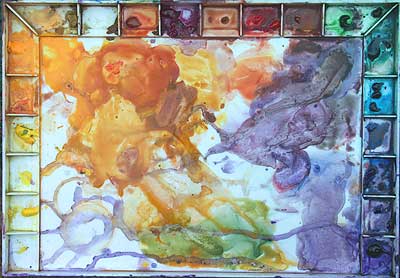mixed media in watercolour painting
The term ‘mixed media’ should be mentioned here as well. But then where does mixed media ever stop? Motor car engine & pencil on paper?
Definitions can be troublesome.
Interesting that the paint manufacturers & merchants use another set of defintions to those of art societies etc.
>>>>>>>>>>>>>>>
transparent & opaque watercolour
The debate between transparent & opaque watercolour has been going on for centuries.
You can read about it in the nineteenth century, especially in England, where the use of new, improved binders & vechiles (increased soulbility) plus new artistic visions made one school of usage of watercolour go transparent because it could go WET. Really wet. Wet washes.
For me, I think an important dividing line is transparent/opaque. It’s precisely the transparency that appeals to me because it’s the solubility & wetness made visible.
It’s also rather difficult. Transparency, as in the political sense of the word, means that you have nothing to hide. You can’t cover over your mistakes.
But then again, opaque pigments. For instance, bismuth yellow is a fabulous 21 century pigment, the bright yellow of pollen on stamens, & it is opaque. However for a real understanding about opaque/transparent, it is necessary to understand the point at which maximum saturation of colour is achieved in watercolour. For instance if you use it straight out of the tube, it dries really rather dull. It needs to be diluted to become alve, as it were. ie WET to be transparent to be colourful. Whilst acrylics & tempera are wonderful medii in their own right, they don’t quiet share so much as watercolour this transformation upon dilution.
You do occassionally see artists describing work as ‘transparent watercolour’.

